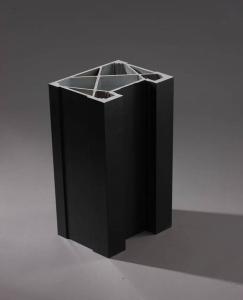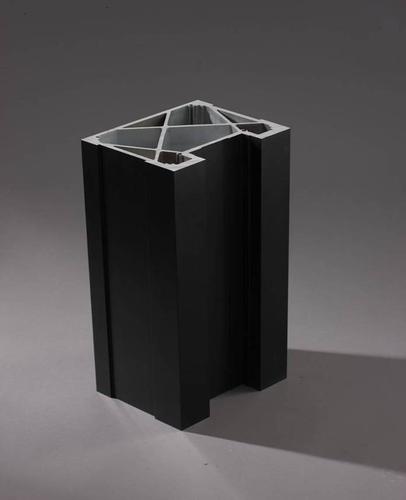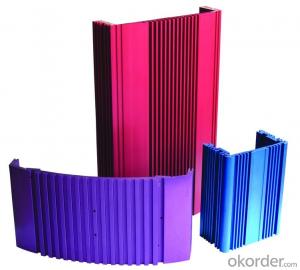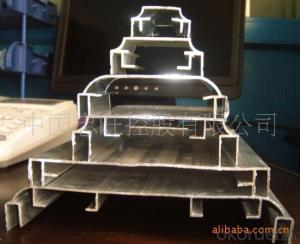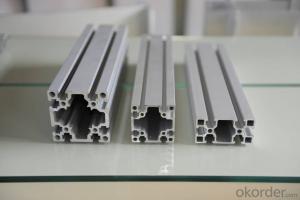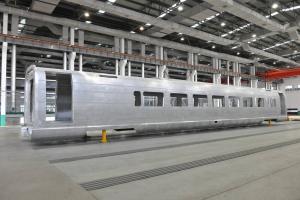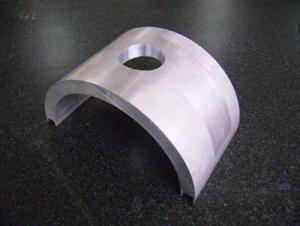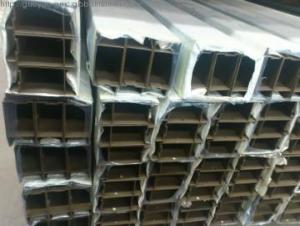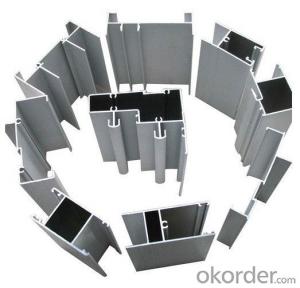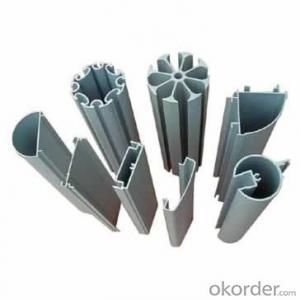Extruded Aluminum Profiles Canada for Machine Crossbeam
- Loading Port:
- China Main Port
- Payment Terms:
- TT OR LC
- Min Order Qty:
- -
- Supply Capability:
- -
OKorder Service Pledge
OKorder Financial Service
You Might Also Like
Aluminum extrusion for machine crossbeam
1. Usage: Crossbeam profile
2. Surface:black anodize
3. Alloy:6005-T6 alloy temper
4. Size:according to customer’s requirement
5. Advantage:Durability, good corrosion resistance and lightweight
6. Package:Normal paper package and soft plastic interleaving each profile to protect the surface. In case of any special package, additional packing cost will be charged.
7. Raw materials varies from pure aluminum to alloy duralumin,
8.Surface Treatment: Anodized , Powder Coating, Electrophoresis, Wooden-pattern transfer, Thermal-break, Sand blasting, mechanical polishing,etc;
9.Color: Any color as per customer demand;
Industrial Aluminium Profiles
1. Various sections for industrial application--heat radiators, flow line, elevators, textile industry, solar energy, vehicle lamps, medical treatment, ship building industry, etc
2. Raw materials varies from pure aluminum to alloy duralumin,
3. Material Type: 6063A, 6063, 6061,6060,6005, etc;
4. Heat Treat.: T5, T6
5. Surface Treatment: Anodized, Powder Coating, Electrophoresis, Wooden-pattern transfer, Thermal-break, Sand blasting, mechanical polishing,etc;
6. Color: Any color as per customer demand;
7. Packing: Plastic film and craft paper wrapping, or wooden crates
- Q: What is the aluminum section table?
- Aluminum frame is used to do the frame, console ah. Jing Teng aluminum professional undertake assembly line workbench ~!
- Q: Are there any materials for aluminum profiles?
- Yes, aluminum, silicon, aluminum, magnesium and so on
- Q: How do aluminum profiles perform in seismic or earthquake-prone areas?
- Aluminum profiles have proven to be highly effective in seismic or earthquake-prone areas due to their unique properties. The lightweight nature of aluminum makes it a popular choice for construction in such areas as it reduces the overall weight of the structure, thus minimizing the potential for collapse during an earthquake. Additionally, aluminum possesses excellent ductility, meaning it can deform under stress without fracturing, which allows it to absorb and dissipate the energy generated by seismic activity. Moreover, aluminum profiles have high strength-to-weight ratio, allowing them to withstand the dynamic forces exerted during an earthquake. This strength, combined with the material's corrosion resistance, makes aluminum profiles particularly suitable for seismic areas where the risk of structural damage is heightened. Furthermore, aluminum is a highly malleable material, making it easy to shape and fabricate into various structural components. This flexibility allows for the creation of customized designs that can withstand seismic forces. Additionally, aluminum profiles can be easily bolted or welded together, providing a secure and reliable connection that further enhances the structural integrity of the building. It is important to note that the performance of aluminum profiles in seismic areas also depends on the overall design and construction techniques used. Proper engineering practices, such as incorporating seismic bracing systems or using specialized connectors, can further improve the performance of aluminum structures during earthquakes. Overall, due to its lightweight, ductile, strong, and corrosion-resistant properties, aluminum has proven to be a reliable and effective material for use in seismic or earthquake-prone areas. When appropriately designed and constructed, aluminum profiles can significantly enhance the safety and resilience of structures in these challenging environments.
- Q: What are the different shapes and profiles available for aluminum profiles?
- Aluminum profiles come in various shapes and profiles, each with its own distinct characteristics and uses. Let's explore some of the most common options: 1. Square and rectangular profiles: These profiles have straight sides and sharp corners, making them perfect for applications that require strength and rigidity. They are frequently utilized in architectural structures, frames, and support systems. 2. T-shape profiles: T-shaped profiles consist of a perpendicular flange or arm extending from a larger base. They are often employed for structural purposes, providing additional strength and support in beams and columns. 3. Round profiles: Round profiles have a circular cross-section and are frequently preferred in applications that demand a smooth and seamless appearance. They are commonly found in decorative uses like handrails, lighting fixtures, and furniture. 4. Angle profiles: Angle profiles have two sides perpendicular to each other, creating a 90-degree angle. These profiles are commonly used in corner protection, edging, and framing applications. They are frequently seen in industries such as construction, manufacturing, and automotive. 5. I-beam profiles: I-beam profiles feature a central vertical web with flanges on either side, forming an "I" shape. These profiles are renowned for their high strength-to-weight ratio and are commonly used in structural applications like bridges, buildings, and heavy-duty machinery. 6. Custom profiles: In addition to the standard shapes mentioned above, aluminum profiles can also be custom-designed and extruded to meet specific requirements. This allows for endless possibilities in terms of shape, size, and functionality. In conclusion, the wide range of aluminum profile shapes and profiles enables versatility and adaptability in various industries and applications. Whether you prioritize strength, aesthetics, or a combination of both, there is an aluminum profile shape and profile that will suit your specific needs.
- Q: What are the different accessories available for aluminum profiles?
- There are various accessories available for aluminum profiles, such as corner connectors, end caps, T-slot nuts, brackets, hinges, handles, leveling feet, and panel fasteners. These accessories help enhance the functionality and versatility of aluminum profiles in different applications, such as constructing frames, enclosures, and machinery.
- Q: What are the reasons for the large number of products in the aluminum profile cutting machine after opening?
- When sawing, lubrication is insufficient, check the lubrication system, and the other may be aluminum material is not good
- Q: What are the different sizes and dimensions of aluminum profiles?
- The different sizes and dimensions of aluminum profiles can vary greatly depending on the specific application and manufacturer. They can range from small, narrow profiles with dimensions of a few millimeters to larger, wider profiles with dimensions of several inches or more. The length of the profiles can also vary, typically ranging from a few feet to several meters.
- Q: Can aluminum profiles be used for staircases and handrails?
- Yes, aluminum profiles can be used for staircases and handrails. Aluminum is a versatile material that offers numerous benefits for these applications. It is lightweight, yet strong and durable, making it suitable for supporting the weight and providing stability for staircases and handrails. Additionally, aluminum is resistant to corrosion, allowing it to withstand exposure to moisture and humidity commonly found in these areas. Its versatility allows for various designs and finishes, making it a popular choice for both modern and traditional styles. Aluminum profiles also offer ease of installation and maintenance, making them a practical and cost-effective solution for staircases and handrails.
- Q: Can aluminum profiles be used for creating lightweight furniture?
- Yes, aluminum profiles can be used for creating lightweight furniture. Aluminum is a lightweight and durable material, making it ideal for constructing furniture that is easy to move and transport. Additionally, aluminum profiles can be easily customized and shaped to create various furniture designs while maintaining their lightweight properties.
- Q: What are the different surface embossing options for aluminum profiles?
- Aluminum profiles offer a variety of surface embossing options, each with its own unique textures and patterns. Some commonly used options include: 1. Diamond pattern: This option creates a diamond-shaped pattern on the profile's surface, providing both visual appeal and improved grip. It is ideal for applications that require slip resistance. 2. Stucco pattern: Stucco embossing creates a textured surface with small, raised bumps. It is often used in applications where aesthetics play a crucial role, such as architectural facades or interior design elements. 3. Hammer tone pattern: This option gives the aluminum profile a hammered texture, providing a distinctive and rustic appearance. It is popular in decorative applications like furniture or light fixtures. 4. Wood grain pattern: Wood grain embossing mimics the texture and look of natural wood. It is commonly chosen for applications like window frames or doors when a traditional or natural appearance is desired. 5. Linen pattern: Linen embossing creates a subtle, fabric-like texture on the profile's surface. It is frequently used in applications that require a sophisticated and elegant finish, such as interior decorative panels or cabinet doors. It's worth noting that these embossing options can be customized or combined to meet specific design requirements. Manufacturers may offer additional options, allowing customers to choose from a wide range of patterns and textures to achieve their desired aesthetic and functional goals.
Send your message to us
Extruded Aluminum Profiles Canada for Machine Crossbeam
- Loading Port:
- China Main Port
- Payment Terms:
- TT OR LC
- Min Order Qty:
- -
- Supply Capability:
- -
OKorder Service Pledge
OKorder Financial Service
Similar products
Hot products
Hot Searches
Related keywords
